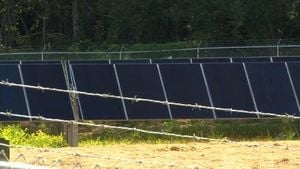The tragic drowning of 13-year-old Kane Edwards in the River Tawe, Swansea, has reignited urgent calls for improved water safety measures in the area, as his family and local officials grapple with the aftermath of an avoidable accident that has left a community in mourning. The incident, which occurred in late May 2022, unfolded on a stretch of river near Swansea Enterprise Park—a spot well-known among local children as a popular swimming location.
According to BBC News, Kane had gone swimming with a friend after school on May 24, 2022, when disaster struck. Unbeknownst to him, hidden dangers lurked beneath the fast-flowing surface. Kane’s foot became entangled in submerged debris—possibly a fallen tree or a discarded trolley, as later discussed at the inquest—and he was unable to free himself. Despite frantic efforts by his friend and a swift response from emergency services, Kane spent more than an hour underwater before he was found and pulled from the river around 6:00 p.m.
The inquest into Kane’s death, held over two days at the Guildhall in Swansea in August 2025, brought to light not only the tragic sequence of events but also the broader safety concerns that have long simmered in the Morriston community. Assistant coroner Edward Ramsay ruled the death accidental, stating, “Kane died by drowning as a consequence of having become trapped by underwater debris in fast-flowing water of the River Tawe at around 4.50pm on May 24, 2022.” The coroner emphasized that Kane was “absolutely not aware of the hazards beneath” when he entered the water, highlighting the invisible risks that can turn a carefree swim into a fatal accident.
One of the most striking revelations from the hearing was the difficulty emergency services faced in pinpointing the exact location of the incident. The Welsh Ambulance Service’s call handler, Hannah Stanley, testified that the what3words app—which is designed to provide precise location data—failed during the emergency call. As a result, valuable minutes were spent trying to clarify Kane’s whereabouts. However, coroner Ramsay was “absolutely satisfied” that while there “may have been some delays,” these had no “causative impact” on the outcome. He concluded, “Kane tragically probably drowned at the moment he was last seen by his friend.”
The post-mortem examination confirmed that Kane had died from drowning after entering freezing water with rock weirs and deep pools, where he was quickly overwhelmed by the current. As reported by BBC News and echoed in local media, neither Kane’s friend nor the police could initially provide a precise location, until the boy suggested a suitable spot for emergency services to park on the correct side of the river. Ambulance crews were dispatched to a nearby point, with their route “updated en route” as more accurate information came in, according to Welsh Ambulance Service manager Andrew Garner.
In the wake of the tragedy, Kane’s family has been vocal about the need for more robust safety measures at the site. His uncle, Gethin Edwards, stated, “Given the spot was a known swimming area for children, at the minimum there should be a lifebuoy present there.” He pointed out that the nearest lifebuoy is a 20-minute walk away from where Kane drowned—a distance that could prove fatal in an emergency. “Just last night there were five or six children swimming in the river in this area,” Gethin said, underscoring the persistent dangers and the likelihood that “Kane was not going to be the first or last person to be swimming there.”
During the inquest, the family also raised the prospect of installing a barrier to restrict access to the river from the footpath that runs alongside it. They described the area as a “notorious” spot for children and expressed deep concern that “this will happen again” without further intervention. Their fears are not unfounded; as noted in court, children continue to swim at the site despite the tragedy, drawn by the same allure that led Kane and his friend to the water that fateful afternoon.
Swansea Council’s water safety manager, Andrew Suter, outlined the steps taken since Kane’s death. In addition to placing six warning signs—five along the footpath and one on a fishing platform—advising people not to swim in the river, the council has installed a lifebuoy at a fishing platform upstream from the accident site. There are also plans to plant hawthorn bushes near the weirs to deter swimmers by making access more difficult. Suter confirmed that, prior to Kane’s death, there had been no recorded incidents at the site, but the council has since conducted a risk assessment and committed to ongoing safety improvements.
The inquest also prompted a review of emergency call handling procedures. Welsh Ambulance Service manager Andrew Garner explained that, following the incident, training has been improved so that automatic location systems are now used first before asking callers for more detail. This change aims to prevent similar confusion in the future and ensure that emergency crews can reach the scene as quickly as possible—a small but significant legacy of Kane’s tragic accident.
Throughout the proceedings, the Edwards family maintained a dignified presence, expressing their gratitude to the emergency services and the wider Morriston community. In a statement read at the hearing, they said, “Kane was taken from us in a tragic accident. We are thankful to the emergency services for all their efforts on the day. We also want to thank the community of Morriston.” The coroner, in closing the inquest, offered his “sincere sympathies and condolences” to the family, acknowledging the profound loss and the heartbreak that now shadows their lives.
As the community comes to terms with Kane’s death, the incident serves as a stark reminder of the hidden dangers that rivers can pose—especially to young swimmers unaware of what lies beneath the surface. The debate over how best to protect children from similar tragedies continues, with the Edwards family’s calls for a lifebuoy and possible barriers echoing in council chambers and among local residents. While some may argue that personal responsibility and parental supervision are paramount, others insist that public authorities must do more to mitigate risks in well-known swimming spots.
For now, the memory of Kane Edwards endures as both a cautionary tale and a catalyst for change. It remains to be seen whether the steps taken so far—signage, foliage, and improved emergency protocols—will be enough to prevent another family from suffering such an unimaginable loss. But one thing is certain: the river that claimed Kane’s life has also sparked a renewed determination to make Swansea’s waterways safer for everyone.
The story of Kane Edwards is a painful chapter in the ongoing struggle to balance the joys of childhood exploration with the imperative of public safety. As summer approaches and the rivers beckon once again, parents, officials, and children alike will be watching—and hoping—that lessons learned from this tragedy will not be forgotten.




